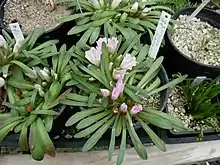Lewisia brachycalyx
Lewisia brachycalyx is a species of flowering plant in the family Montiaceae, known by the common name short-sepal bitter-root or shortsepal lewisia.[1] It is native to the mountains of the southwestern United States and Baja California,[1] where it grows in moist habitat such as meadows. It is a deciduous perennial growing from a short thick taproot and caudex unit. It produces a basal rosette of thick, fleshy, blunt-tipped narrow leaves up to 8 centimeters long. The inflorescence is under 4 centimeters tall, taking the form of a cluster of several flowers sitting atop the leaf rosette. Each flower has 5 to 9 shiny white or pink petals about 2 centimeters long. At the center are many stamens and stigmas clumped together.[2] The Latin specific epithet brachycalyx means “having a short calyx”.[3]
| Lewisia brachycalyx | |
|---|---|
 | |
| Scientific classification | |
| Kingdom: | Plantae |
| Clade: | Tracheophytes |
| Clade: | Angiosperms |
| Clade: | Eudicots |
| Order: | Caryophyllales |
| Family: | Montiaceae |
| Genus: | Lewisia |
| Species: | L. brachycalyx |
| Binomial name | |
| Lewisia brachycalyx | |
This plant is hardy down to −10 °C (14 °F) but requires well-drained, acid to neutral pH soil in full sun. It becomes dormant after flowering in the summer. It is a suitable subject for an alpine garden where it can be given the conditions that best replicate its natural habitat. It has gained the Royal Horticultural Society’s Award of Garden Merit.[4][5]
The genus Lewisia was moved in 2009 from the purslane family (Portulacaceae) with adoption of the APG III system, which established the family Montiaceae.
References
- "Lewisia brachycalyx". Calflora.org. Retrieved 22 March 2018.
- Brickell, Christopher, ed. (2008). The Royal Horticultural Society A-Z Encyclopedia of Garden Plants. United Kingdom: Dorling Kindersley. p. 624. ISBN 9781405332965.
- Harrison, Lorraine (2012). RHS Latin for Gardeners. United Kingdom: Mitchell Beazley. ISBN 184533731X.
- "RHS Plantfinder - Lewisia brachycalyx". Retrieved 22 March 2018.
- "AGM Plants - Ornamental" (PDF). Royal Horticultural Society. July 2017. p. 60. Retrieved 22 March 2018.